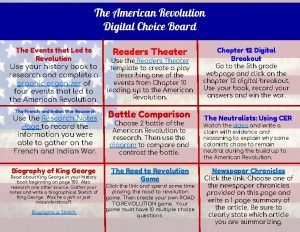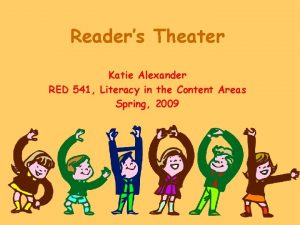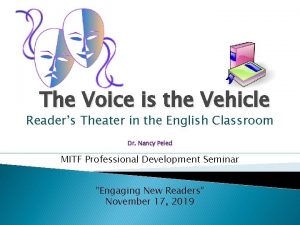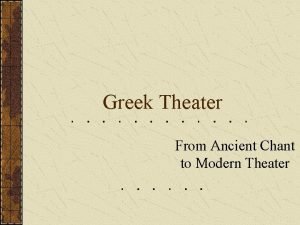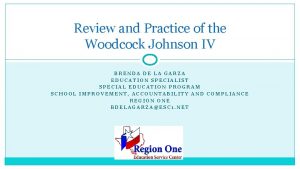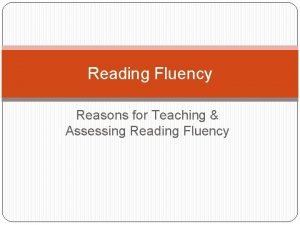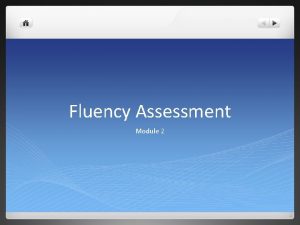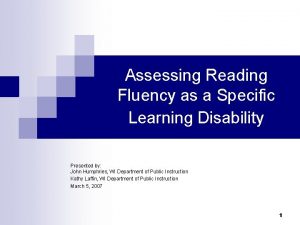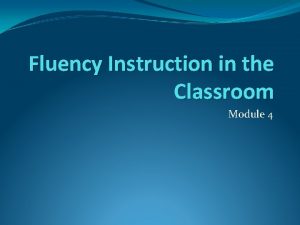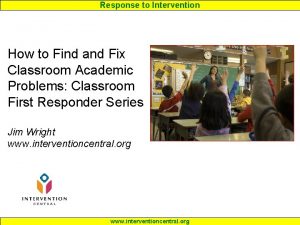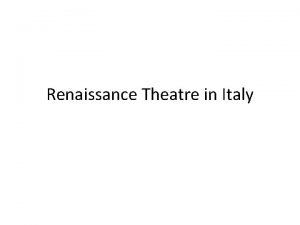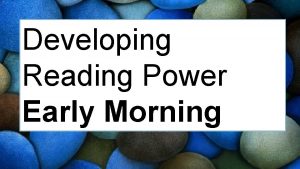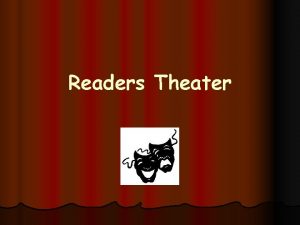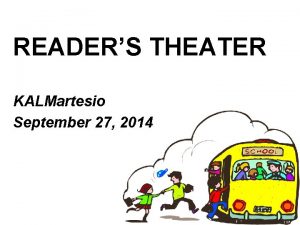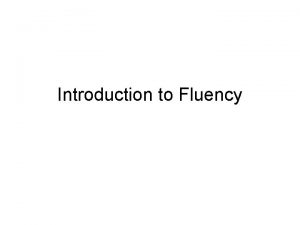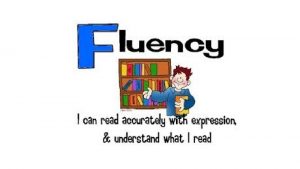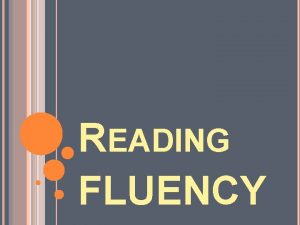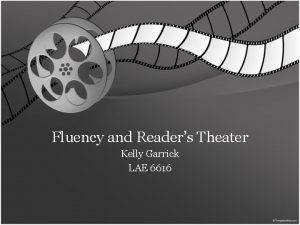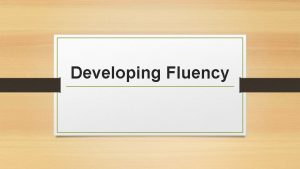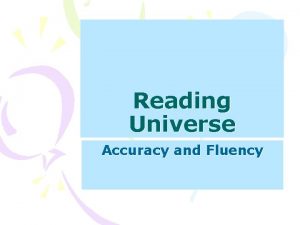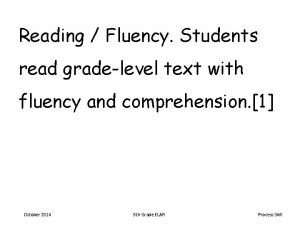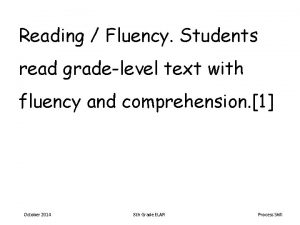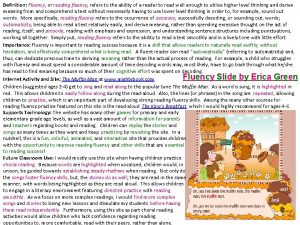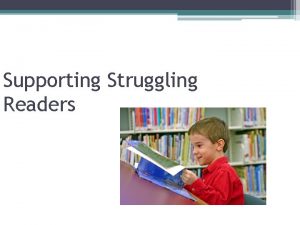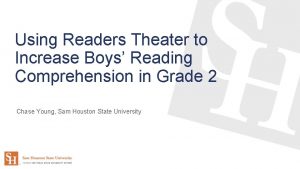Developing Fluency with Readers Theater History of Reading




















- Slides: 20

Developing Fluency with Readers Theater

History of Reading Fluency • • Hyatt, 1943 Goodman, 1964 La. Berge & Samuals, 1974 Allington, 1983 Dowhower, 1991 National Reading Panel, 2000 Valencia & Buly, 2004 Snowling & Hulme, 2005

Components of Reading Fluency Accurate Word Recognition Automaticity

Repeated Reading (Samuels, 1979)

Components of Reading Fluency Prosody

Practicing Prosody Rasinski on DIBELS Video

Performance-Based Activities

• Monday: Select scripts and read for meaning • Tuesday: Choose parts and focus on automaticity • Wednesday: Focus on Prosody • Thursday: Practice Performance • Friday: Performance (Griffith & Rasinski, 2004; Martinez, Roser, Strecker, 1998; Young & Rasinski, 2009; Vasinda & Mc. Leod, 2011; Worthy, 2005; Worthy & Prater, 2002

Implementing Readers Theater Video

RT Plus Comprehension and Vocabulary Day Monday Building Fluency with Gradual Comprehension Release Teacher Models Texts to be As a whole group, generate questions while performed on Friday. Students reading the script. follow along and discuss the quality of the teacher’s reading. Word Study Choose, discuss, and analyze unknown words. Add to word wall. Tuesday Choral reading of script. Students choose their scripts, and the Choose, discuss, and teacher helps students generate a summary analyze interesting of their respective scripts. words. Add to word wall. Wednesday Small Group rehearsal. Teacher coaches. Students assign parts and rehearse in their assigned groups. Teacher goes from one group to another coaching and giving encouragement and talking about meaning of the script. Choose, discuss and analyze root words and/or affixes words. Add to word wall. Thursday Practice – Dress Rehearsal Class does a run through of the scripts and texts to be performed. Afterwards, students retell the script in their own words to a partner. Choose, discuss and analyze content vocabulary (if any). Add to word wall. Friday Perform After the performance, students discuss what they liked most about their script and what could have been done to make the script even better. Read and discuss word wall chorally

• Mentor Text • Parody – Sophia Finds a Turtle • Scratch – King Kong vs. Second Grade VIDEO

Poetry Academy Wilfong (2008) 1. Students choose a poem 2. Rehearse the poem daily 3. Recite to a volunteer • Or… Have a full on poetry slam! • Day 1: Choose a poem and read for overall meaning • Day 2: Word Identification • Day 3: Prosody • Day 4: Practice for a Partner • Day 5: Dim the lights, dress in black, and enjoy the poetry slam – don’t forget to “snap clap”

Rock and Read


Student Produced Movies • • Phase 1: Grouping Phase 2: Idea Development Phase 3: Script Treatment Phase 4: Storyboard Phase 5: Scripting Phase 6: Preproduction Conference Phase 7: Filming Phase 8: Post-Production

Literacy Skills and Processes • Consider reading preferences (Pachtman & Wilson, 2006) • Explore genres (Risko & Walker-Dalhouse, 2011). • Visually represent sequences of text (Naughton, 2008), • Compose summaries (NICHD, 2000) • Transform texts into dialogue ideal for movie production (Culham, 2011; Dorfman & Cappelli, 2007; Young & Rasinski, 2011) • Students utilize software to produce a movie (National Governors Association for Best Practices & Council of Chief State School Officers, 2010)

The Bad News SPM Written and Produced by Second Graders Genre: Horror. Method: Mentor Video

References Culham, R. (2011). Reading with a writer’s eye. In T. Rasinski (ed. ), Rebuilding the Foundation, Effective Reading Instrution for the 21 st Century (pp. 245 -270). Bloomington, IN: Solutiontree. Dorfman, L. R. , & Cappelli, R. (2007) Mentor texts: Teaching writing through children’s literature, K-6. Portland, Maine: Stenhouse. Dunn, M. W. (2011). Ask, reflect, text: Illustrating story plans with art. Journal Of Research In Childhood Education, 25(4), 376 -389. Griffith, L. W. , & Rasinski, T. V. (2004). A focus on fluency: How one teacher incorporated fluency with her reading curriculum. The Reading Teacher, 58(2), 126– 137. doi: 10. 1598/ RT. 58. 2. 1. House, E. R. (1979). Coherence and credibility: The aesthetics of evaluation. Educational Evaluation And Policy Analysis, ERIC, Ipswich, MA. Accessed December 27, 2012 Kist, W. (2000). Beginning to Create the New Literacy Classroom: What Does the New Literacy Look Like? Journal of Adolescent and Adult Literacy, 43, 710 -718. Krathwohl, D. R. (2002). A revision of Bloom’s taxonomy: An overview. Theory into Practice, 41, 212264. Lapp, D. , Moss, B. , & Rowsell, J. (2012). Envisioning new literacies through a lens of teaching and learning. The Reading Teacher, 65(6), 367 -377.

References Martinez, M. , Roser, N. L. , & Strecker, S. (1998). “I never thought I could be a star”: A readers theatre ticket to fluency. The Reading Teacher, 52(4), 326– 334. National Institute of Child Health and Human Development. (2000). Report of the National Reading Panel. Teaching children to read: An evidence-based assessment of the scientific research literature on reading and its implications for reading instruction (NIH Publication No. 00 -4769). Washington, DC: U. S. Government Printing Office. Naughton, V. M. (2008). Picture It! Reading Teacher, 62(1), 65 -68. Pachtman, A. B. , & Wilson, K. A. (2006). What do the kids think? Reading Teacher, 59(7), 680 -684. Rasinski, T. V. , Reutzel, D. R. , Chard, D. , & Linan-Thompson, S. (2011). Reading Fluency. In M. L. Kamil, P. D. Pearson, B. Moje, & P. Afflerbach (Eds. ). Handbook of Reading Research, Volume IV (pp. 286 -319). New York: Routledge. Risko, V. J. , & Walker-Dalhouse, D. (2011). Drawing on text Features for reading comprehension and composing. Reading Teacher, 64(5), 376 -378.

References Smith, F. (1994). Writing and the writer (2 nd edition). Hillsdale, NJ: Lawrence Erlbaum Associates, Publishers. Vasinda, S. , & Mc. Leod, J. (2011). Extending readers theatre: A powerful and purposeful match with podcasting. The Reading Teacher, 64, 486 -497. Worthy, J. (2005). Readers theater for building fluency: Strategies and scripts for making the most of this highly effective, motivating, and research-based approach to oral reading. New York: Scholastic. Worthy, J. , & Prater, K. (2002). “I thought about it all night”: Readers Theater for reading flu- ency and motivation. The Reading Teacher, 56(3), 294– 297. Young, C. , & Rasinski, T. (2009). Implementing Readers’ Theater as an approach to classroom fluency instruction. The Reading Teacher, 63(1), 4– 14. doi: 10. 1598/RT. 63. 1. 1 Young, C. , & Rasinski, T. (2011). Enhancing authors' voice through scripting. The Reading Teacher, 65(1), 24– 28. Young, C. , & Rasinski, T. (2013). Student produced movies as a medium for literacy development, The Reading Teacher.
 Critical reading meaning
Critical reading meaning American revolution digital breakout answers
American revolution digital breakout answers ²www
²www Where the wild things are readers theater
Where the wild things are readers theater Civil war readers theater
Civil war readers theater Greek theater vs modern theater
Greek theater vs modern theater Woodcock johnson iv subtests
Woodcock johnson iv subtests Word reading
Word reading Reading fluency checklist
Reading fluency checklist Cbm reading fluency passages
Cbm reading fluency passages Definition of reading fluency
Definition of reading fluency Fluency oriented reading instruction
Fluency oriented reading instruction Intervention central reading fluency
Intervention central reading fluency While reading activities
While reading activities History of the globe theatre
History of the globe theatre Italian renaissance theatre
Italian renaissance theatre Where did medieval theatre originated
Where did medieval theatre originated Ancient greek theatre history
Ancient greek theatre history Origin of drama in greece
Origin of drama in greece Characteristics of intensive reading
Characteristics of intensive reading Developing reading power grade 2
Developing reading power grade 2

